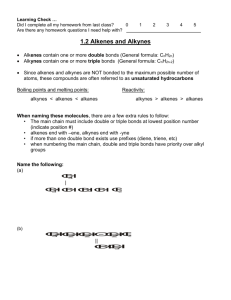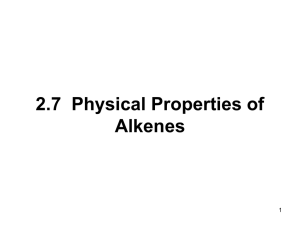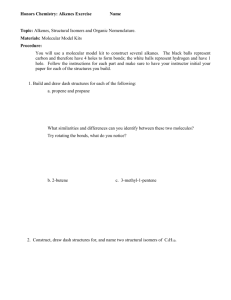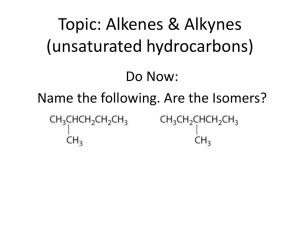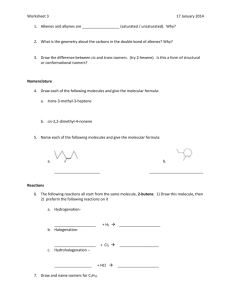Chapter 3
advertisement
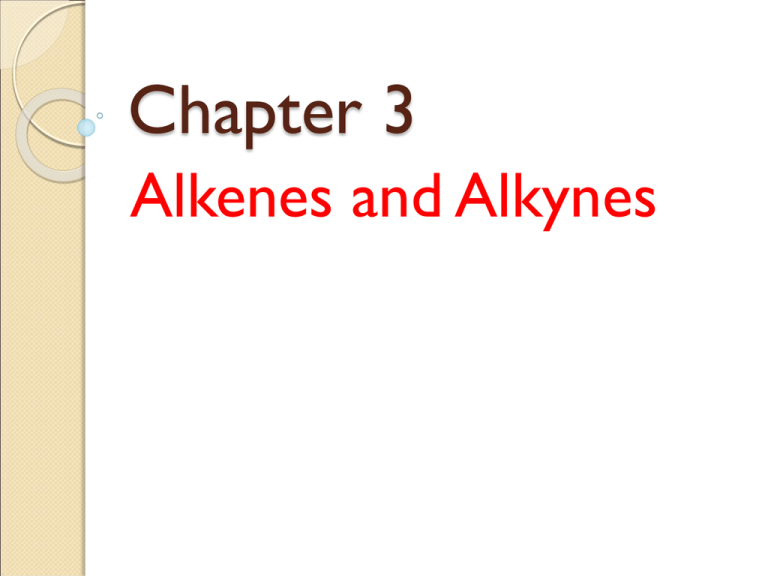
Chapter 3 Alkenes and Alkynes Alkenes and Alkynes Alkene:A hydrocarbon that contains one or more carbon-carbon double bonds. • Ethylene is the simplest alkene. Alkyne:A hydrocarbon that contains one or more carbon-carbon triple bonds. • Acetylene is the simplest alkyne. Alkenes Structure: ◦ The VSEPR model predicts bond angles of 120° about each carbon of a double bond. ◦ In ethylene, the actual angles are close to 120°. ◦ In substituted alkenes, angles about each carbon of the double bond may be greater than 120° because of repulsion between groups bonded to the double bond. Alkenes Cis-trans isomerism • Because of restricted rotation about a carbon-carbon double bond, an alkene with two different groups on each carbon of the double bond shows cis-trans isomerism. • Aka as geometric isomers Alkenes Examples Which of the following compounds can exist as cistrans isomers? Alkenes—IUPAC Names To name an alkene; • The parent name is that of the longest chain that contains the C=C. • Number the chain from the end that gives the lower numbers to the carbons of the C=C. • Locate the C=C by the number of its first carbon. • Use the ending -ene to show the presence of the C=C • Branched-chain alkenes are named in a manner similar to alkanes in which substituted groups are located and named. Alkenes—IUPAC Names Examples Cycloalkenes To name a cycloalkene: • Number the carbon atoms of the ring double bond 1 and 2 in the direction that gives the lower number to the substituent encountered first. • Note that it is not necessary to explicitly number the position of the double bond in a cycloalkene as in linear alkenes. • Number and list substituents in alphabetical order. Cycloalkenes • Alkenes that contain more than one double bond are named as alkadienes, alkatrienes, and so forth. • Those that contain several double bonds are referred to more generally as polyenes (Greek: poly, many). Examples Draw the condensed structure of the following compounds a. 3,3-dimethylcyclohexene b. trans-1-bromo-2,3-dimethyl-2-hexene Examples Give the IUPAC name for each of the following compounds Alkynes—IUPAC Names Follow the same rules as for alkenes, but use the ending -yne to show the presence of the triple bond. Examples Name the following compounds Common Names Common names are still used for some alkenes and alkynes, particularly those with low molecular weight. Physical Properties • Alkenes and alkynes are nonpolar compounds. • The only attractive forces between their molecules are London dispersion forces. • Their physical properties are similar to those of alkanes with the same carbon skeletons. • Alkenes and alkynes are insoluble in water but soluble in one another and in nonpolar organic liquids. • Alkenes and alkynes that are liquid or solid at room temperature have densities less than 1.0 g/mL; they float on water. Reactions of Alkenes Reactions of Alkenes Most alkene addition reactions are exothermic. ◦ the products are more stable (lower in energy) than the reactants. ◦ Just because they are exothermic doesn’t mean that alkene addition reactions occur rapidly. ◦ Reaction rate depends on the activation energy. ◦ Many alkene addition reactions require a catalyst. Addition of HX Addition of HX (HCl, HBr, or HI) to an alkene gives a haloalkane. Acid-Catalyzed hydration reaction ◦ H adds to one carbon of the C=C and X to the other. ◦ Reaction is regioselective. One direction of bond forming (or bond breaking) occurs in preference to all other directions. Reactions of Alkenes ◦ Markovnikov’s rule: H adds to the less substituted carbon and X to the more substituted carbon. Examples Give the major product obtained from the acidcatalyzed hydration of each of the following alkenes reactions Addition of H2O Addition of water is called hydration. ◦ Hydration is acid catalyzed, most commonly by H2SO4. ◦ Hydration follows Markovnikov’s rule; H adds to the less substituted carbon and OH adds to the more substituted carbon. Addition of Cl2 and Br2 Addition takes place readily at room temperature. • Reaction is generally carried out using pure reagents, or mixing them in a nonreactive organic solvent. • Addition of Br2 is a useful qualitative test for the presence of a carbon-carbon double bond. • Br2 has a deep red color; dibromoalkanes are colorless. Addition of Cl2 and Br2 • Addition of Br2 is a useful qualitative test for the presence of a carbon-carbon double bond. • Br2 has a deep red color; dibromoalkanes are colorless Addition of H2—Reduction Virtually all alkenes add H2 in the presence of a transition metal catalyst, commonly Pd, Pt, or Ni. Addition of H2—Reduction Figure 3.1 The addition of hydrogen to an alkene involving a transition metal catalyst. Examples Predict the products of the following reaction and determine the major product Examples Draw a line-angle for an alkene with the molecular formula C5H10 that reacts with HCl to give the indicated chloroalkane as the major product. More than one alkene may give the same compound as the major product Polymerization From the perspective of the organic chemical industry, the single most important reaction of alkenes is polymerization: • polymer: Greek: poly, many, and meros, part; any longchain molecule synthesized by bonding together many single parts, called monomers. • monomer: Greek: mono, single and meros, part. Polymerization • Show the structure of a polymer by placing parentheses around the repeating monomer unit. • Place a subscript, n, outside the parentheses to indicate that this unit repeats n times. • The structure of a polymer chain can be reproduced by repeating the enclosed structure in both directions. • The following is a section of polypropene (polypropylene). Polymerization Ethylene Polymers Polyethylene Low-density polyethylene (LDPE): ◦ A highly branched polymer; polymer chains do not pack well and London dispersion forces between them are weak. ◦ Softens and melts above 115°C. ◦ Approximately 65% of all LDPE is used for the production of films for packaging and for trash bags. High-density polyethylene (HDPE): ◦ Only minimal chain branching; chains pack well and London dispersion forces between them are strong. ◦ Has higher melting point than LDPE and is stronger ◦ Can be blow molded to squeezable jugs and bottles. Polyethylene Figure 12.2 Fabrication of LDPE film.
